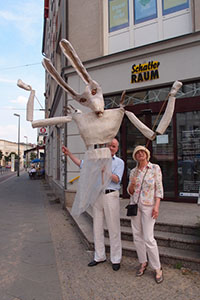
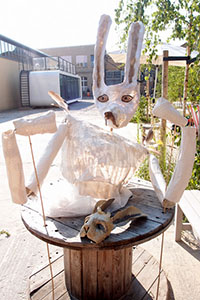
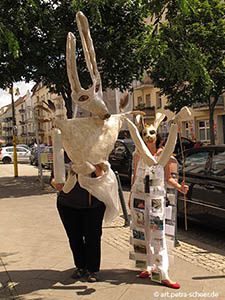
|
Liz Crossley
|
>Home | >Projects | >The Hare |
 |
 |
|
Walking the Hare in Oberschöneweide... with Michael Maria Kammertöns and Karin Karg (left image). Many thanks to the costume designer Uschi Marr (behind the hare in the right image) for helping to create this unusual creature. Many thanks to Petra Scheer for the image of Liz Crossley and Uschi Marr (third from left). Visiting Daniel Eltinger at his exhibition and studio during the Spreeknie festival (images below). |
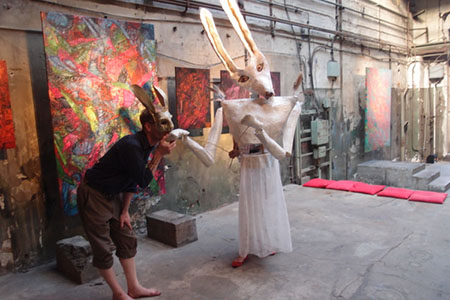 |
|
Introducing the hare, as an artist. Back in the old time, the question, „What happens to us when we die?“ started to worry the (San) people, so it was decided to send a little boy to the Moon to ask for enlightenment. The chosen boy ran and ran over all the earth till he got to the Moon. Exhausted, he fell on his knees and breathlessly panted out the question. The Moon rolled out a long philosophical story and ended by saying, „When people die, they die as I do. When I die I always come again, new!“ The boy jumped up and made the same exhausting journey back to his people, who were waiting impatiently for the answer. Maybe he was exhausted, maybe he had not understood the message, because he blurted out, „The moon says when we die we really die!“ The people were shocked and a cloud of depression settled over them. The Moon saw their sadness and found out that the boy had given the wrong message. Angrily the Moon hit the boy on the mouth, turning him into a hare, but as he was a San boy, he became the artist among the animals. |
Den Hasen als Künstler vorstellen. Vor langer Zeit begann die Frage „Was geschieht mit uns nach dem Tod?“ das (San) Volk zu beunruhigen und so entschlossen sie sich, einen kleinen Jungen zum Mond zu schicken um nach Aufklärung zu bitten. Der Auserwählte rannte über die ganze Erde bis er zum Mond kam. Erschöpft fiel er dort auf die Knie und nach Luft ringend stieß er die Frage aus. Der Mond lieferte eine lange philosophische Geschichte und sagte abschließend „Wenn Menschen sterben, sterben sie wie ich. Wenn ich sterbe, komme ich immer wieder neu zurück!“ Der Junge sprang hoch und machte sich auf denselben mühsamen Weg zurück zu seinem Volk, das ungeduldig auf die Antwort wartete. Vielleicht war er erschöpft, vielleicht hat er auch die Botschaft nicht verstanden, denn aus ihm platzte: „Der Mond sagt, wenn wir sterben, tun wir das tatsächlich!“ Das Volk war schockiert und eine Wolke der Bedrückung schlug sich über es nieder. Der Mond sah dessen Unglück und fand heraus, dass der Junge die falsche Botschaft übergeben hatte. Zornig schlug er dem Jungen auf den Mund und verwandelte ihn somit in einen Hasen, aber da er ein San Junge war, wurde er zum Künstler der Tiere. |
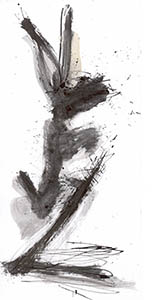 |
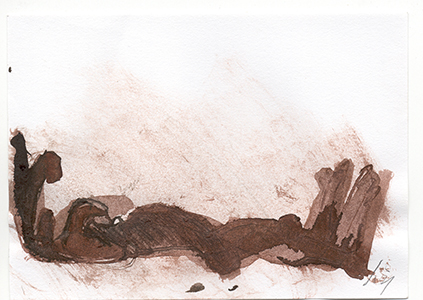 |
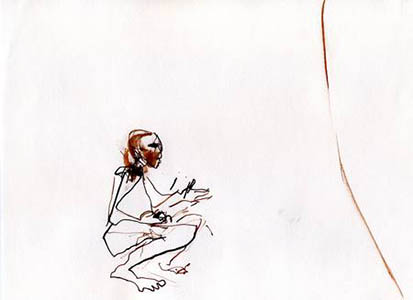 |
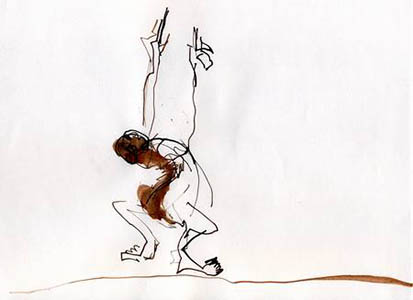 |